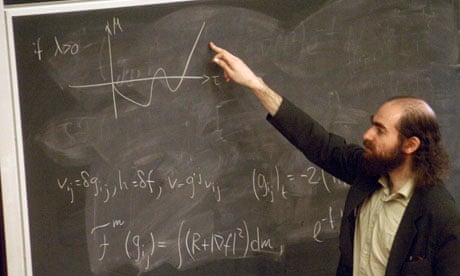By any standards, Grigori Perelman makes a marvellous subject for a biography. Arguably the world's greatest mathematician, he worked out a solution to one of the seven great unsolved mathematical problems, the Poincaré conjecture, in 2002. It was a magnificent achievement. Honours, cash, offers of world lecture tours and lucrative teaching posts were hurled at the Russian theorist.
But Perelman turned down the lot, including the Fields medal, the mathematical world's equivalent of a Nobel prize, and a million dollars in prize money that the Clay Institute wanted to give him for his work. Since then, he has announced he has given up the study of mathematics altogether and has cut off communications with all journalists and nearly all his friends.
What, you might ask, is that all about? Why strive for truth and glory and then give it all up when you have achieved it? Gessen, a US writer born of Russian parents, decided to find out. The result is an unorthodox but intriguing work. "I had no extended interviews with Perelman," she admits. "In fact, I had no conversations with him at all."
Instead, Gessen, whose previous books have included an investigation of her own genetic history, Blood Matters, and a history of the Russian intelligentsia, Dead Again, sought out the lecturers and professors who nurtured the talent of Perelman and who turned him into the fragile genius who cracked the Poincaré problem. Thus we are plunged into the murky waters of Soviet mathematics in the 70s and 80s – "a vicious, backstabbing little world, shaped by intrigue, denunciation and unfair competition," as Gessen puts it. "A mathematician had to be ideologically reliable and personally loyal not only to the party but to existing members of the establishment, and Jews and women had next to no chance of getting in."
Given that his parents were Jewish, Perelman, who was born in 1966, was fortunate in those who took up his cause. These were his "guardian angels", as Gessen terms them, men who included Sergei Rukshin, who shepherded the "pudgy and awkward" Perelman through mathematics clubs at school; Alexander Golovanov, who supervised his graduate studies; and Mikhail Gromov, who eased his path into the outside world and put him on the path to glory.
By the time he graduated, Perelman had acquired the accoutrements of a fully fledged eccentric. He had stopped cutting his hair, which, with his unkempt beard, made him look like an exasperated Rasputin; he had stopped cutting his nails; and while in New York on a postgraduate course, he wore the same brown corduroy jacket and ate only one kind of black bread for his entire stay (he procured the bread from a Russian shop in Brooklyn, to which he walked every day from Manhattan). Clearly, this was a man who was unlikely to be bothered about the difficulties involved in finding solutions to the odd unsolved mathematical conjecture or two.
In 1995, Perelman returned to the Steklov Mathematical Institute in St Petersburg, where he showed up infrequently and generally kept to himself for the next seven years as he worked on his proof of the Poincaré conjecture, one of the greatest mathematical breakthroughs of the past 100 years.
Posted on the web in 2002, Perelman's paper triggered massive interest among mathematicians and he was showered with offers of professorial appointments and research money which, by all accounts, he found gravely insulting. The monetisation of achievement is the ultimate insult to mathematics, he claimed. "So profound was his disappointment with the rewards he was offered that, I believe, it contributed a great deal to his subsequent decision to quit mathematics altogether, along with the people who practise it," says Gessen. (Perelman now lives with his mother on the outskirts of St Petersburg.)
This strange tale highlights the intensity of the world of modern mathematics and the nature of some of the semi-autistic savants who live in it. Certainly, it is a heady subject, though the Perelman story poses special problems for any author trying to tackle it. For a start, there is the simple fact that the man at the centre of these events will not speak out on the subject (or any other for that matter).
Gessen works hard to get round this and has been dogged in following the main players in Perelman's life. These efforts, by and large, pay off. Perfect Rigour is readable, coherent and enjoyable and we get a distinct image of a man crippled by his inabilities to empathise with or understand other men or women. Nevertheless, this is a life viewed from odd angles, rather than faced head on.
Gessen is also hobbled by the inscrutable nature of the Poincaré conjecture. Developed by Henri Poincaré in 1904, it states that "every simply connected, closed 3-manifold is homeomorphic to the 3-sphere" and is concerned with the characterisation of a three-dimensional sphere. It has key implications for understanding the new-born universe after the big bang but it is very much for mathematicians only.
Given these issues, producing a readable, coherent book about Perelman is no easy task. Nevertheless, Gessen succeeds – more or less.

Comments (…)
Sign in or create your Guardian account to join the discussion